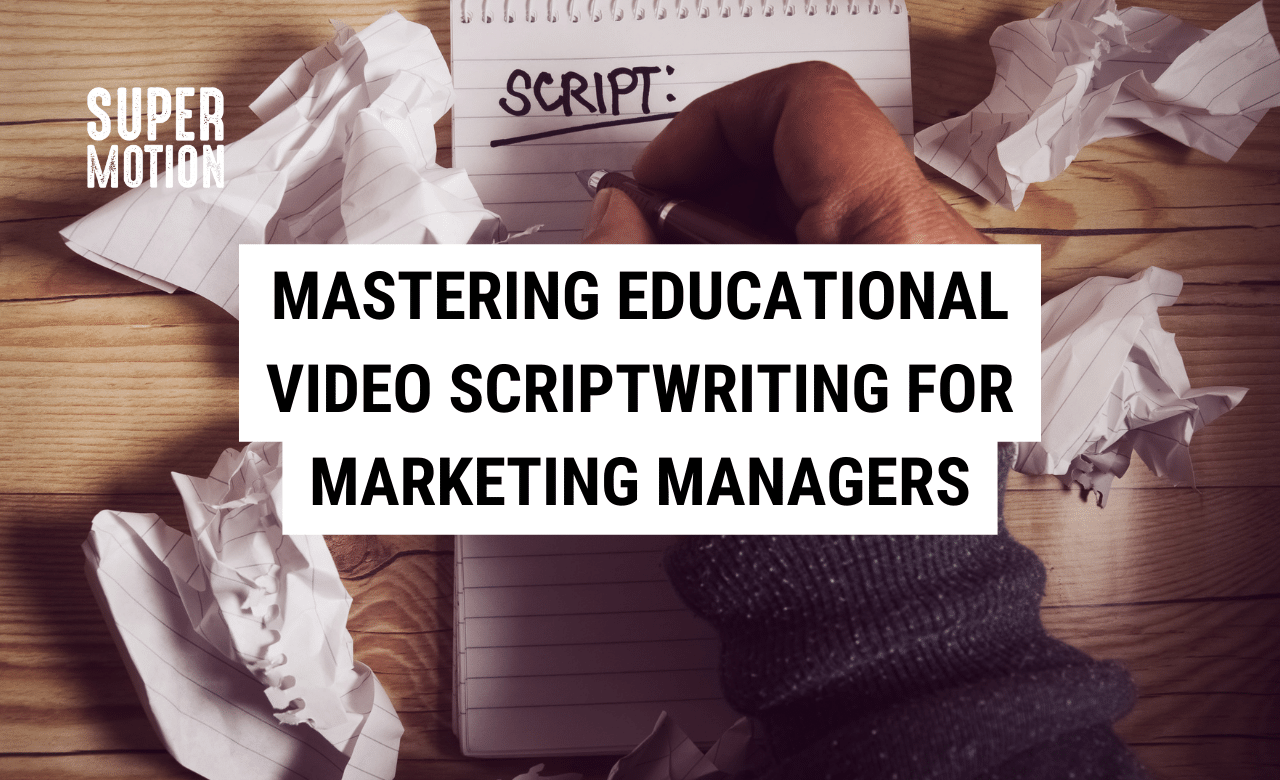Mastering Educational Video Scriptwriting for Marketing Managers

Crafting a compelling educational video script is a quintessential skill for any Marketing Manager in a bustling digital age. With the demand for high-quality, engaging video content on the rise, your ability to script an instructional video that resonates with your demographic is paramount.
This guide aims to offer the blueprint for creating educational video content that not only informs, but also inspires action — from the first word of your script to the final frame of your video.
The Essence of Educational Video Scriptwriting
The heart of any effective video lies in its script. As a Marketing Manager, your script is your strategic playbook, guiding your team towards a shared vision and your audience towards your call to action. It outlines the narrative, ensures clarity of message and brand voice, and sets the tone for the visual content that brings your messaging to life. In this guide, you’ll discover the art of writing educational video scripts that captivate audiences, and drive your marketing goals forward.
Understanding Your Audience
Before penning a single word of your script, it is imperative to understand the audience you are addressing. A deep grasp of your audience’s demographics, psychographics, and viewing habits, steers content towards relevance and ensures the investment of time and resources is not misplaced.
Step 1: Define Your Target Demographic
Begin by identifying the characteristics of the group you wish to engage. Age, gender, location, education level, occupation, and income can all play a significant role in tailoring your messaging. For example, your script for a tech-savvy millennial audience will differ greatly from one targeted at retired professionals looking to learn about new mobile technologies.
Step 2: Analyse Viewers’ Knowledge and Interests
Are you addressing novices in your field, or experienced specialists? The level of understanding your audience has on your topic should guide the depth of your content. Furthermore, understanding their passions and pains allows you to inject empathy and relevance into your script, fostering a strong connection.
Step 3: Study Viewing Habits
How your audience consumes video is critical. Are they on the go, where shorter, punchier material may be more effective? Or are they dedicated to learning, making a larger scope of content more appropriate? Consumption on platforms like YouTube could mean that more informal language and a personal, engaging delivery are preferred, compared to content shared on LinkedIn, for example.

Crafting the Message
With your audience firmly in mind, the next step is to craft a compelling and educational message that not only imparts knowledge, but also tells a story. This narrative should align closely with your audience analysis to ensure it piques interest and maintains attention.
Step 1: Define the Objective
What is the primary goal of your educational video? Are you aiming to explain a complex process, teach a new skill, or increase awareness of a product feature? Your objective shapes the entire narrative. For example, if your objective is to teach a new skill, a step-by-step guide with a clear progression will be most effective.
Step 2: Develop Key Messages
Identify the core principles or takeaways you want your audience to remember. These key messages should be the focal point of your script, woven into the narrative and reinforced through repetition. However, avoid being overly repetitive or didactic; instead, find natural and various ways to embed these messages throughout the script.
Step 3: Tell a Compelling Story
Humans are wired to connect through stories. Your educational video should have a beginning, middle, and end, with a clear narrative arc. Use real-world examples, personal anecdotes, or case studies to illustrate and bring your content to life. A relatable story not only makes your content more digestible, it adds emotional weight and stake in the viewer’s understanding.
Structure and Flow
Establishing a solid structure ensures your video unfurls methodically, maintaining viewer engagement and allowing for a natural absorption of information. Clarity and a logical flow make complex topics reachable and digestible.
Step 1: Introduction
Grab your viewers’ attention in the first few seconds. Clearly state what the video is about and why they should watch it. An intriguing statistic, a thought-provoking question, or a bold statement, can set the stage for the educational content that follows.
Step 2: Main Content
Organise the main body of your script in a coherent and progressive manner. For instructional videos, this is often a series of steps or a logical progression of topics. Use transitions and segment titles to break down the information, making it more manageable and less overwhelming.
Step 3: Conclusion
Share a brief summary that reinforces your key messages and provides closure to your narrative. This is also the time to lead your audience into the next step — whether it is to continue learning with a follow-up video, explore your product, or engage with your brand on social media.

Visual and Verbal Synchronisation
Synchronising the verbal delivery of your script with visual elements is crucial for an impactful and effective educational video. It is the marriage of audio and visual that allows for a multi-faceted learning experience and creates a dynamic output.
Step 1: Storyboard Creation
Before shooting, create a storyboard that maps out each scene in sync with your script. This visual guide ensures that every point in your script has a complementing image, animation, or action to reinforce the spoken word.
Step 2: Visual Relevancy
Every visual you choose, whether it’s live-action footage, animation, or graphics, should directly relate to the content of the script. Visuals that do not serve to clarify or enhance your message can confuse the audience and dilute the impact of your video.
Step 3: Rhythm and Pacing
The flow of your script must match the rhythm and pacing of your video. Slow-paced content should include visuals that hold the audience’s eyes, such as detailed graphics or animations. Conversely, high-energy sections might employ fast cuts or lively motion to match the script’s intensity.
Crafting a Clear Call to Action
Your video may educate and inform, but it should also compel your viewers to take the next step. A well-crafted call to action is the bridge between passive viewers and active participants in your marketing strategy.
Step 1: Make It Relevant
Your call to action must be relevant to the content of your video and the interests of your audience. Whether it’s an invitation to learn more, to visit a website, to purchase a product, or to subscribe, it should tie back to the educational value provided in the script.
Step 2: Keep It Clear and Concise
A convoluted call to action can confuse and deter your audience. Be direct and clear in what you’re asking them to do. Use action verbs and imperative language to prompt immediate and clear response.
Step 3: Provide Incentive
If appropriate, offer your audience a compelling reason to follow through with your call to action. This could be exclusive content, a discount, or an opportunity to engage further with your brand.

Revision Strategies
Your first draft of the script likely won’t be perfect, and that’s where the revision process becomes indispensable. It’s through the process of revision that a good script can transform into an excellent one.
Step 1: Collaborative Review
Work with your team or additional stakeholders to gather different perspectives. Each review can offer fresh insights and identify areas for improvement, from clarity of content to the engagement factor.
Step 2: Cut the Fluff
Every word in your script should have a purpose. Eliminate any content that does not serve the main educational objective or provide value to your audience. Reflect on the overall flow and ensure that the narrative progression is clear and logical.
Step 3: Test and Adjust
Once you have a polished script, consider testing it with a small group representative of your target audience. Their feedback is invaluable and may reveal any last-minute adjustments that can be made to optimise the effectiveness of your script.

Ready to Script Your Next Educational Video?
Educational videos are a powerful tool in any Marketer’s arsenal. They can build brand loyalty, position your company as an authority in your field, and provide tangible value to your viewers. By leveraging the strategies outlined in this guide, you can elevate your educational video content and strengthen your connection with your audience.
If you’re looking to supercharge your educational video marketing and need a partner who can master the art of digital storytelling, Super Motion is here to help you create videos that captivate, educate, and drive results. Reach out today to book a free 30-minute strategy call with our team of video production experts. It’s time to bring your educational video content to life.
